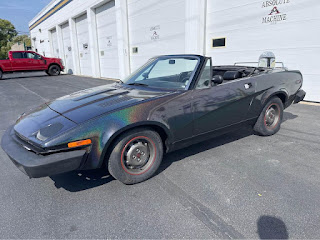When I was kid growing up on Long Island in the '70's, a neighbor had not only had a TR7, but a TR6. Born an old soul, I usually liked "older" cars more than whatever was then current, but I thought the TR7 made the TR6 look like old timey, pre-war cars I generally don't care for; us old souls have out limits. I really, really liked that TR7 and I still do. This one is a 1980, it's a rare convertible and is for sale on Marketplace for "just" $6,000. Somebody, hide my checkbook!
I realize that liking TR7's more than TR6' makes me an odd duck in the eyes of Triumph cognoscenti - many a Triumph sports car fan want nothing to do with these cars; I don't see what they don't see or why they despise them. I guess since there's nothing in common between a "7" and a "6" and I seeing the "7" before the "6", I'm able to see them exclusive of each other. I do, for the record, see plenty to love in almost all TR's going back to the first one in 1961, but given a choice between a "7" and an earlier TR, I'm going with one of these. Let's agree to disagree on TR2's and 3's.
New for mid-model-year 1975, the TR7 was Triumph's, or, more specifically, British-Leyland's, first "modern sports car" although some of its engineering was decidedly "retro-grade". It was "unit-body" with front-disc brakes, had rack-and-pinion steering and front MacPherson struts, but it had a carbureted four-cylinder engine that was less powerful than the (primitively) fuel-injected six in the TR6 and had a live rear axle versus the TR6' independent rear suspension. That said, we all know that a good live axle set up will trump an IRS.
Despite that, the TR7 was a bastion of civility if not solidity compared to the body-on-frame TR6. Contemporary road-tests lauded it's handling and interior ergonomics (layout\design). Originally built with only a fixed roof, British Leyland was hesitant at first to build a convertible seeing the U.S. government was purportedly banning convertibles, but for 1979, they sawed the roof off creating a roadster. Even amongst TR7 fans I'm the odd duck out as I like the fixed roof models more than these things. The lack of a roof, through my goggles, accentuates the rear-end on these cars and not in a good way.
These cars had more than their fair share of challenges and issues inherent with many a British manufactured automobile in those days. Shoddy build quality, questionable engineering and, like I intimated, its overall design was off-putting to many. Sales were initially strong but then tapered off as word spread that they were unreliable little stinkers. A Rover V-8 (1979-1981 TR8) did little for sales and British Leyland ceased production after 1981; they snuffed out the Triumph brand after 1984.
Still, it's not every day you find one for sale on Facebook Marketplace. And one with a tantalizingly reasonable asking price. I'm not crazy about the color of this one - apparently, it's a vinyl wrap and not paint. Not sure why anyone would go through the trouble of doing that but it's no doubt less expensive in the long run than painting a car. It has a new gas tank and new top, engine appears to have some issues as it "needs gaskets" and a water pump. Yeah, let me run down to Autozone and pick one up. Poster of the ad claims some 200 hours have gone into restoration "at this point". You have, as the saying goes, been warned.






No comments:
Post a Comment